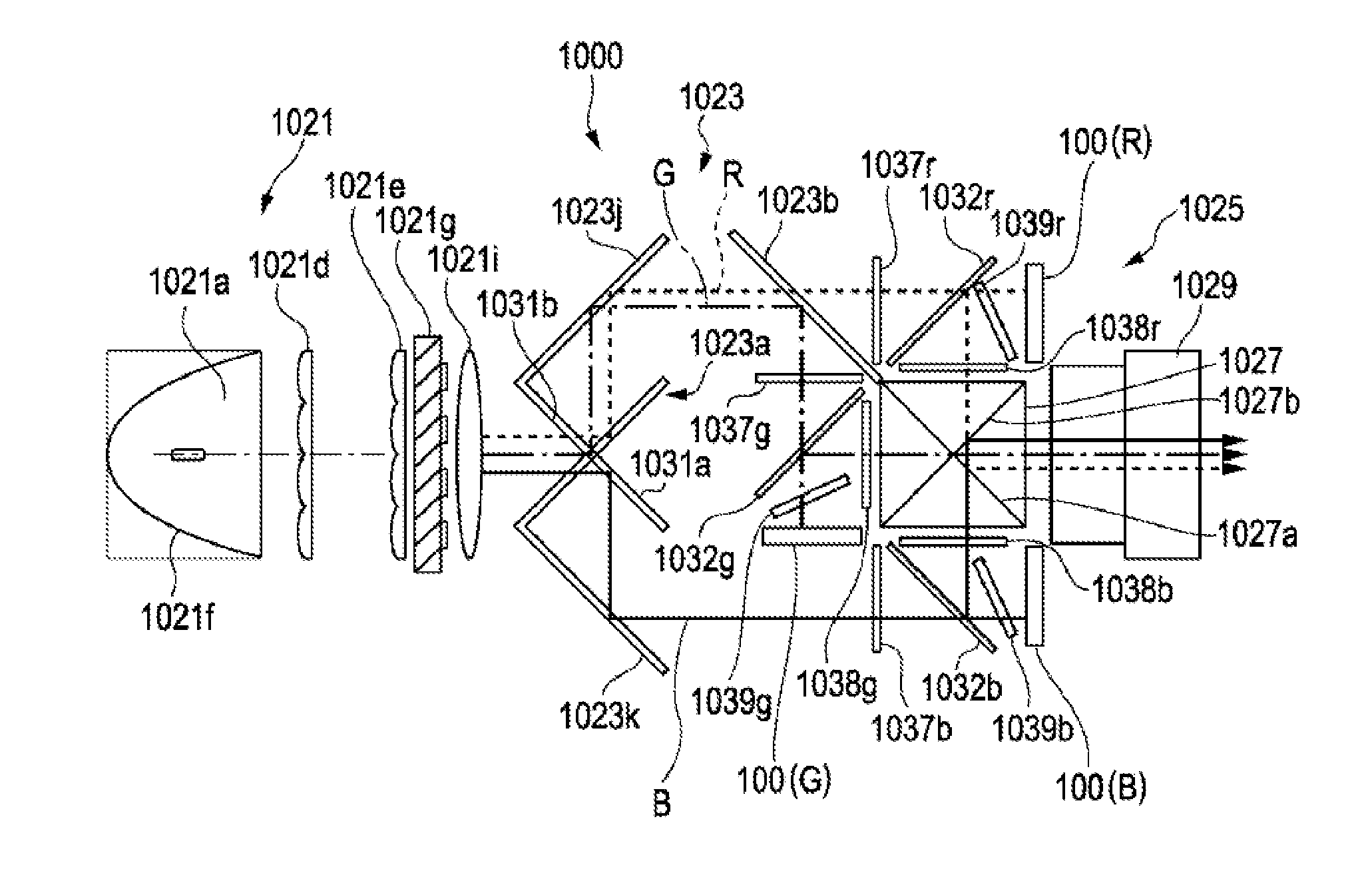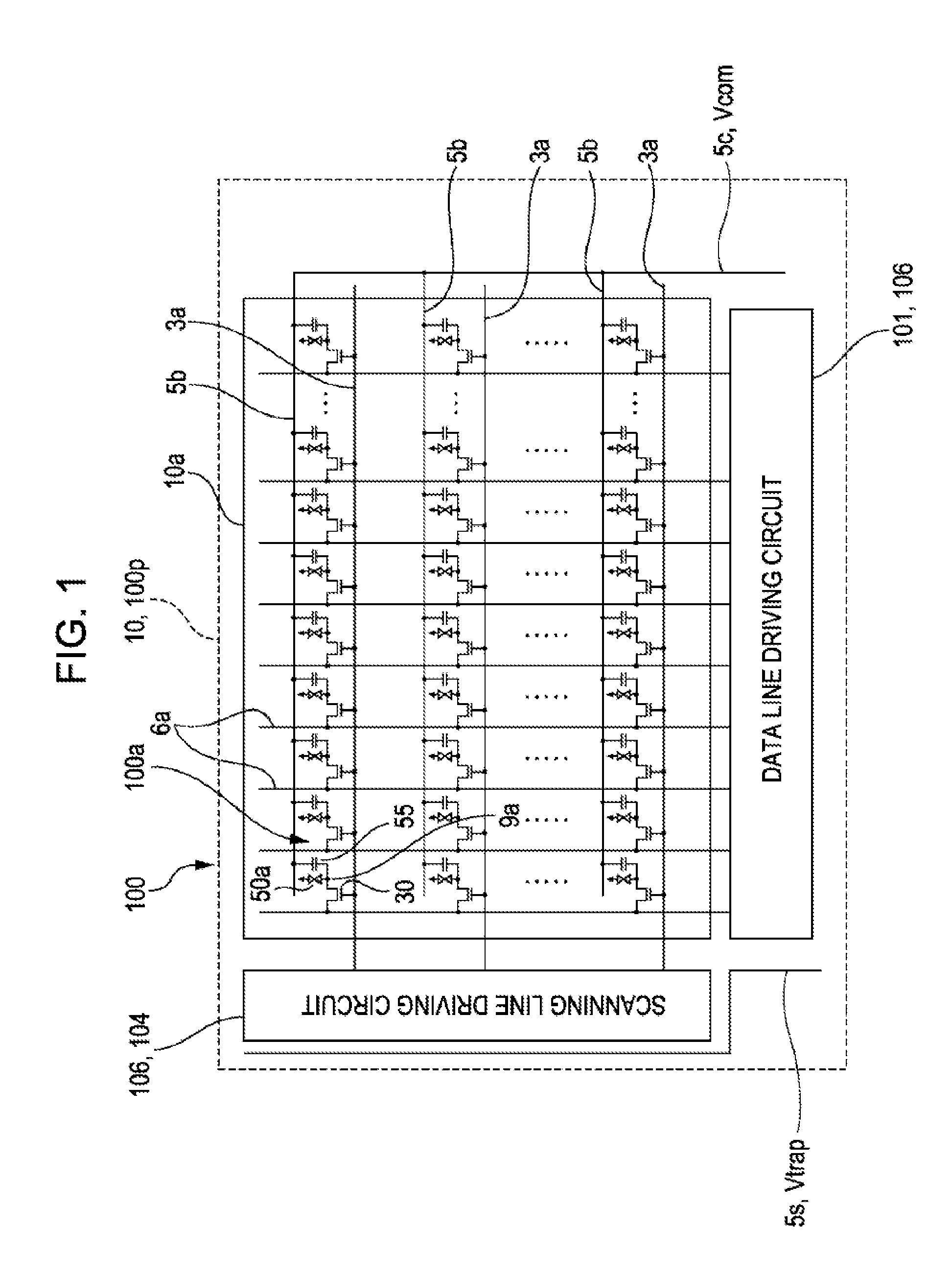Liquid crystal device and projection-type display apparatus
a liquid crystal device and display apparatus technology, applied in non-linear optics, instruments, optics, etc., can solve the problems of inability to cure, inability to reliably prevent aggregation of ionic impurities in image display regions, and inability to cause burn-in (discoloration) of images, etc., to achieve the effect of increasing the number of ionic impurities and easy to affect the quality of images
- Summary
- Abstract
- Description
- Claims
- Application Information
AI Technical Summary
Benefits of technology
Problems solved by technology
Method used
Image
Examples
first embodiment
Overall Configuration
[0029]FIG. 1 is a block diagram illustrating an electrical configuration of a liquid crystal device to which an embodiment of the invention is applied. In addition, FIG. 1 is a block diagram illustrating only the electrical configuration and does not illustrate shapes of wires and electrodes, extension directions, layouts, and the like.
[0030]In FIG. 1, a liquid crystal device 100 has a liquid crystal panel 100p in a TN (Twisted Nematic) mode or a VA (Vertical Alignment) mode, and the liquid crystal panel 100p includes an image display region 10a (image display region) having a plurality of pixels 100a arranged in a matrix form at the center region. In the liquid crystal panel 100p, in an element substrate 10 (see FIGS. 2A and 2B and the like) described later, a plurality of data lines 6a and a plurality of scanning lines 3a extend vertically and horizontally inside the image display region 10a, and pixels 100a are configured at positions corresponding to the int...
second embodiment
[0074]FIG. 7 is a diagram illustrating the peripheral electrode 8a formed on the element substrate 10 of the liquid crystal device 100 according to a second embodiment of the invention. In addition, in FIG. 7, the number of the pixel electrodes 9a, the dummy pixel electrodes 9b, and the like is reduced for illustration. Since the basic configuration of this embodiment is the same as that of the first embodiment, like elements that are common are denoted by like reference numerals, and description thereof will be omitted.
[0075]In the first embodiment, all the second, third, and fourth portions 8a2, 8a3, and 8a4 have the electrode width Wa. However, in this embodiment, as illustrated in FIG. 7, a configuration is employed in which, from among the second, third, and fourth portions 8a2, 8a3, and 8a4, the portions that extend in a region where the peripheral region 10b has a large width extend with the electrode width Wa, and the portions that extend in a region where the peripheral reg...
third embodiment
[0080]FIG. 8 is a diagram illustrating the peripheral electrode 8a formed on the element substrate 10 of the liquid crystal device 100 according to a third embodiment of the invention. In addition, in FIG. 8, the number of the pixel electrodes 9a, the dummy pixel electrodes 9b, and the like is reduced for illustration. Since the basic configuration of this embodiment is the same as that of the first embodiment, like elements that are common are denoted by like reference numerals, and description thereof will be omitted.
[0081]In the second embodiment, the electrode width Wa of the third and fourth portions 8a3 and 8a4, the electrode width Wb of the first portion 8a1, and the electrode width Wc of the second portion 8a2 have the following relationship of the electrode width Wa8a1 and the electrode width Wc of the second portion 8a2 are equal to each other. That is, the electrode width Wa of the third and fourth portions 8a3 and 8a4, the electrode width Wb of the first portion 8a1, and...
PUM
| Property | Measurement | Unit |
|---|---|---|
| width Wa | aaaaa | aaaaa |
| width Wa | aaaaa | aaaaa |
| width | aaaaa | aaaaa |
Abstract
Description
Claims
Application Information
 Login to View More
Login to View More - R&D
- Intellectual Property
- Life Sciences
- Materials
- Tech Scout
- Unparalleled Data Quality
- Higher Quality Content
- 60% Fewer Hallucinations
Browse by: Latest US Patents, China's latest patents, Technical Efficacy Thesaurus, Application Domain, Technology Topic, Popular Technical Reports.
© 2025 PatSnap. All rights reserved.Legal|Privacy policy|Modern Slavery Act Transparency Statement|Sitemap|About US| Contact US: help@patsnap.com



